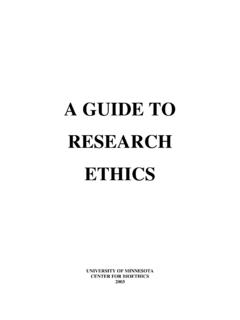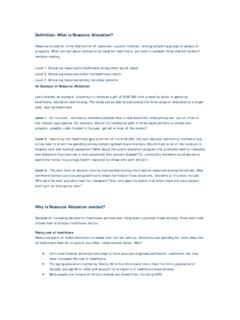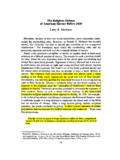Transcription of Definition: What are Chimeras? How and why are they …
1 ChimerasDefinition Ethical Issues Links Suggested Reading End Notes Definition: What are Chimeras? How and why are they produced?Chimeras are animals composed of cells that originate from two (or more) different species. In the research lab, chimeras are created by introducing cells from one species into the developing embryo or fetus of another. (The name chimera comes from Greek mythology and describes a creature with the head of a lion, the body of a goat, and the tail of a serpent).The first chimeras helped scientists understand questions about developmental biology. A sheep-goat chimera, created in 1984, had the head of a goat and the woolly coat of a Chicken-quail chimeras have also been successfully ,iii Sheep-Goat Chimera Courtesy of Dr. Gary B. Anderson -University of California, DavisNow, researchers are developing human-animal chimeras to study disease processes, test new drugs, and develop organs for future transplant patients.
2 The chimeras are produced by introducing human stem cells into developing animal embryos. The following are some of the major projects utilizing human-animal chimeras underway in the and internationally: Sheep-to-humans organ transplant project: At the University of Nevada at Reno, researchers have added human stem cells to sheep fetuses to create chimeras that they hope will someday serve as a reliable source of organs for liver transplant patients. Some sheep now have livers with up to 80% human cells that produce the compounds normally made by human livers. (The cells are not all in distinct liver lobes but spread throughout the tissue. The sheep also have human cells in their hearts and brains).iv,vPigs-to-humans organ transplant project: Mayo Clinic researchers in Minnesota are studying how specially-bred pigs could be used as sources of organs for human transplant patients.
3 Part of their work involves determining the risk of transmitting pig diseases to humans who would receive the They have developed a line of pigs that have pig blood cells, human blood cells, and a new kind of blood cells with characteristics of both humans and An unexpected development in this project may help researchers formulate an explanation for the appearance of the AIDS virus in with human brain cells for the study of neurologic diseases and mice with human immune systems for AIDS drug testing: At Stanford University, researcher Irving Weissman is heading a project that injects human neural stem cells into mouse fetuses. The result is mice with brains that are about 1% human. The researchers want to increase that percentage to 100% human brains in mice bodies in order to better understand the development of Parkinson s, Alzheimer s, and Lou Gehrig s diseases.
4 Weissman is director of the Stanford Institute of Cancer/Stem Cell Biology and Medicine, which developed a line of mice with immune systems that were almost all human. They were able to use the mice to test the response of the AIDS virus to new Rabbit-human hybrids for stem cell research: In 2003, for the first time, researchers at the Shanghai Second Medical University developed embryos that contained both human and animal DNA. Working with rabbit embryos, the researchers goal was to develop a new source of embryonic stems cells for medical research. The resulting embryos contained mostly human DNA (derived from skin cells) and a small amount of rabbit DNA. The researchers harvested the stem cells after a few days, which destroyed the ,xHybrids and chimeras are biologically different. A cell from a chimera contains the genetic material of either one parent species or the other.
5 While each cell from a hybrid animal, such as a mule, contains genetic material from both parent species. Monkey-human chimeras for the study of Parkinson s disease: At St. Kitts Biomedical Foundation in the Caribbean, scientists are transplanting immature human brain cells deep into the brains of vervet monkeys. Their goal is to develop a treatment for Parkinson s disease. They inject immature human brain cells into the dopamine-producing area of the monkeys brains to see whether the cells can grow and increase dopamine production. (The monkeys are taken from the overabundant wild population on the island of St. Kitts.)xiIn April, 2005, the National Academies (which advises the federal government and the public on scientific and medical issues) released recommended guidelines for embryonic stem cell research, including research on chimeras.
6 While the guidelines are not legally binding, they are likely to have a significant impact on research in the because funding agencies and professional societies (through which scientists publish their work) are likely to abide by the complete Guidelines for Human Embryonic Stem Cell Research are available online at: can read an announcement and summary of the Guidelines online at Regulations and recommendations on chimera research generally lag behind ongoing projects and vary across international boundaries. For example, while it is ongoing in other countries, Canada bans research on human-animal ,xiv,xvTop of Page Ethical Issues Because human-animal chimeras contain human cells or even tissues or organs that are primarily human ethical concerns surround the question of just what or who chimeras are. Because they were created under laboratory conditions for research purposes, are chimeras lab animals?
7 Or, will chimeras eventually be developed that are too human to be considered otherwise?Ethical issues of primary concern for bioethicists, researchers, animal rights activists and others interested in chimeras can be divided into two broad categories: a) complete opposition to research of this kind and b) concerns about particular research methods to be used and outcomes that may ensue. Opposition to Chimera Research There are those who are convinced that human-animal chimera research should not be performed at all. The following are their reasons for opposing all such research: 1. Because it involves research on human embryos. Even if the embryos are not destroyed, the research combines human and animal genetic material with unknown and perhaps unknowable results. Richard Doerflinger, Deputy Director of the Secretariat for Pro-Life Activities at the Conference of Catholic Bishops, told the The Boston Globe regarding human-animal chimeras: I think it would be basically immoral to create a human whose status we could not determine.
8 We'd have an unresolvable dilemma about how to treat this animal. xvi William Cheshire, a Mayo Clinic associate professor of neurology in Jacksonville, Florida, and a member of Christian Medical and Dental Associations expressed his concerns in National Geographic: Research projects that create human-animal chimeras risk disturbing fragile ecosystems, endanger health, and affront species integrity. We must be cautious not to violate the integrity of humanity or of animal life over which we have a stewardship responsibility. xvii 2. Because it disregards the welfare of animals and animal species involved: The Humane Society of the United States (online at ) communicates its opposition to all chimera research in the position statement, Genetic Engineering of Animals : "The creation of chimeras (organisms composed of cells from individuals of two or more species) involves serious ethical concerns that should be taken into consideration.
9 Creation of chimeras contributes to the debasement of animals, as humankind manipulates nature by combining cells of an array of organisms. As far as current application of chimera research goes, The HSUS is concerned about pain and distress that the animals may undergo and calls on the research community to carefully address the welfare of these animals and to minimize any pain and distress resulting from this type of animal use. 3. More specifically, because it disregards the welfare of higher primates involved. Higher primates, especially chimpanzees, are closely related to humans and thus may be seen as ideal research subjects in chimera experiments: Jeremy Rifkin, noted biotechnology activist, opposes chimera research because it crosses species boundaries. In his view, animals have the right to exist without being tampered with, especially because he finds that other research methods could lead to the same medical (Rifkin is the author of The Biotech Century, a best-seller about the biotech revolution.)
10 Together with Dr. Stuart A. Newman, a professor of cell biology and anatomy at New York Medical College, Rifkin applied for a patent on chimera research techniques, including ones that would combine human and monkey or ape cells into a single humanzee embryo. In another, human and mouse cells would form a humouse embryo. Their goal was to challenge biotechnology efforts that would produce these and Newman were pleased when the Patent and Trademark Office (PTO) turned down their application. By applying for a patent on the humanzee, humouse, and other part-human embryos and animals, we hoped to alert the general public to the need for regulations and restrictions in this area, Newman said in an interview with Science and Theology News. While the PTO has been issuing patents on living organisms since a 1980 Supreme Court Decision, the human chimera application was rejected in 2005 primarily because the PTO has no way to determine how human an organism can be before it is not patentable by the 13th Amendment's prohibition of slavery , according to It is still legal to produce these chimeras without a patent, but may not be financially feasible for a biotech company to develop products based on techniques that are not protected by a patent.












